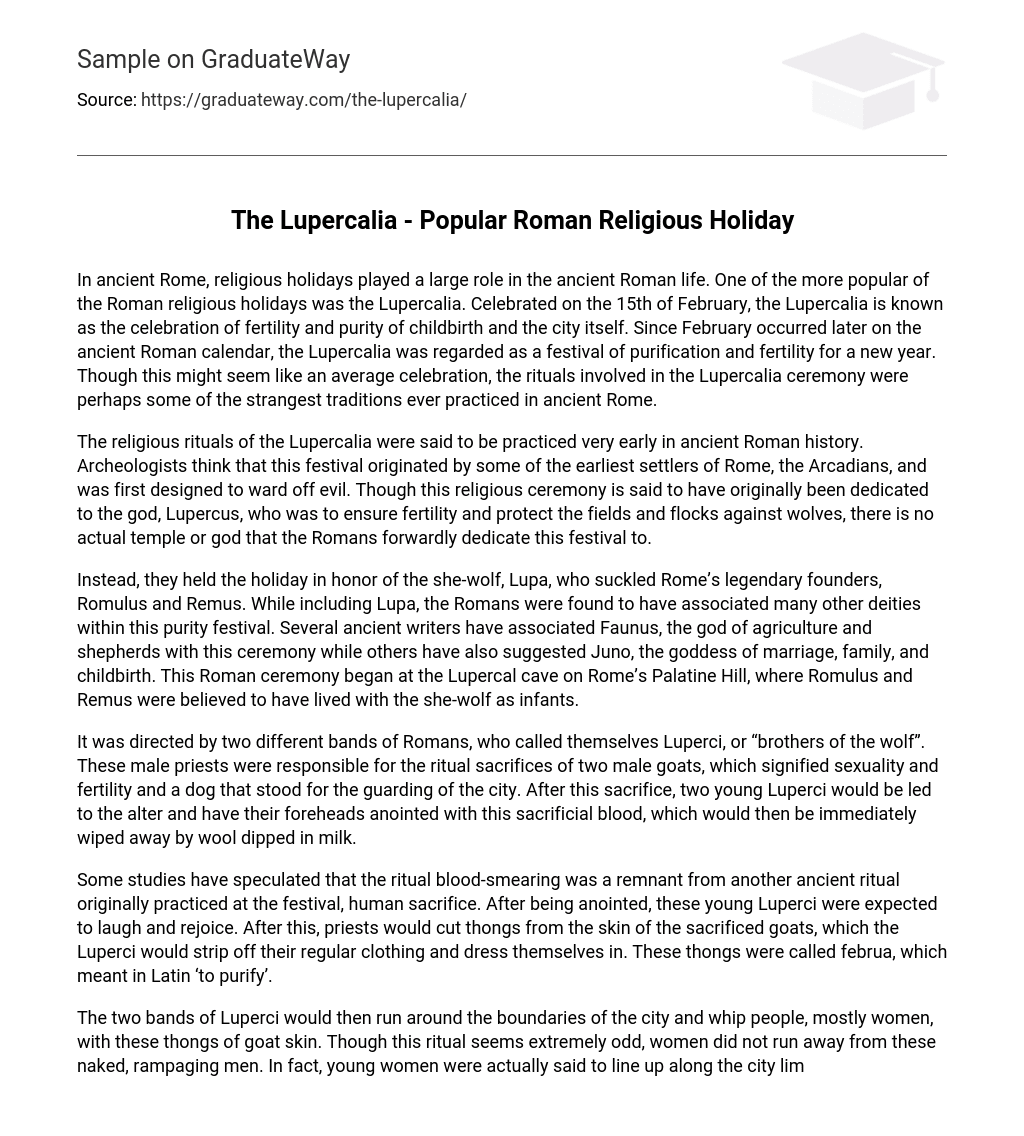In ancient Rome, religious holidays played a large role in the ancient Roman life. One of the more popular of the Roman religious holidays was the Lupercalia. Celebrated on the 15th of February, the Lupercalia is known as the celebration of fertility and purity of childbirth and the city itself. Since February occurred later on the ancient Roman calendar, the Lupercalia was regarded as a festival of purification and fertility for a new year. Though this might seem like an average celebration, the rituals involved in the Lupercalia ceremony were perhaps some of the strangest traditions ever practiced in ancient Rome.
The religious rituals of the Lupercalia were said to be practiced very early in ancient Roman history. Archeologists think that this festival originated by some of the earliest settlers of Rome, the Arcadians, and was first designed to ward off evil. Though this religious ceremony is said to have originally been dedicated to the god, Lupercus, who was to ensure fertility and protect the fields and flocks against wolves, there is no actual temple or god that the Romans forwardly dedicate this festival to.
Instead, they held the holiday in honor of the she-wolf, Lupa, who suckled Rome’s legendary founders, Romulus and Remus. While including Lupa, the Romans were found to have associated many other deities within this purity festival. Several ancient writers have associated Faunus, the god of agriculture and shepherds with this ceremony while others have also suggested Juno, the goddess of marriage, family, and childbirth. This Roman ceremony began at the Lupercal cave on Rome’s Palatine Hill, where Romulus and Remus were believed to have lived with the she-wolf as infants.
It was directed by two different bands of Romans, who called themselves Luperci, or “brothers of the wolf”. These male priests were responsible for the ritual sacrifices of two male goats, which signified sexuality and fertility and a dog that stood for the guarding of the city. After this sacrifice, two young Luperci would be led to the alter and have their foreheads anointed with this sacrificial blood, which would then be immediately wiped away by wool dipped in milk.
Some studies have speculated that the ritual blood-smearing was a remnant from another ancient ritual originally practiced at the festival, human sacrifice. After being anointed, these young Luperci were expected to laugh and rejoice. After this, priests would cut thongs from the skin of the sacrificed goats, which the Luperci would strip off their regular clothing and dress themselves in. These thongs were called februa, which meant in Latin ‘to purify’.
The two bands of Luperci would then run around the boundaries of the city and whip people, mostly women, with these thongs of goat skin. Though this ritual seems extremely odd, women did not run away from these naked, rampaging men. In fact, young women were actually said to line up along the city limits and bare their flesh praying to be whipped, as this ‘ritual whipping’ was believed to bring fertility and ease the pain of childbirth. the priests would hold a feast for all the Luperci participating, serving the meat of their sacrifices.
This festival was so popular that it continued to be celebrated long after the Christianization of the Roman Empire. This new religion forced the church to replace pagan festivals with festivals more suited to the new faith. In order to do so, Romans usually kept the days of the festivals the same to ease the introduction of the new religion, but changed the name and the reason for the festival. In 496 AD Pope Gelasius ended the festival of Lupercalia and refashioned it as St. Valentine’s Day, declaring St. Valentine the patron saint of lovers who would be honored at the new festival on the fourteenth of every February. Today, many believe our annual Valentine’s Day is originated by this festival.
Works Cited
Fanklin, Alberta “The Lupercalia” Faculty of Philosophy Columbia University March, 1921 Smith, William “A dictionary of Greek and Roman antiquities” Taylor and Walton, 1842 Volume 1 pg. 583 Web 03 Dec. 2011 <http://depthome. brooklyn. cuny. edu/classics/dunkle/romnlife/luprclia. htm>





